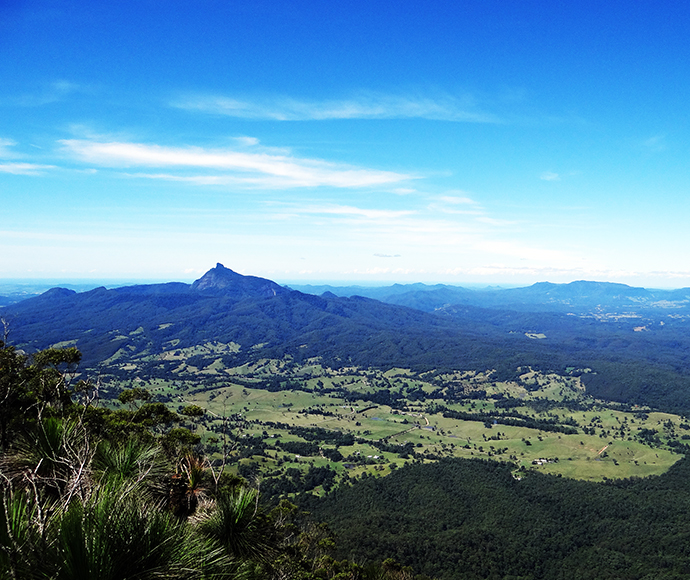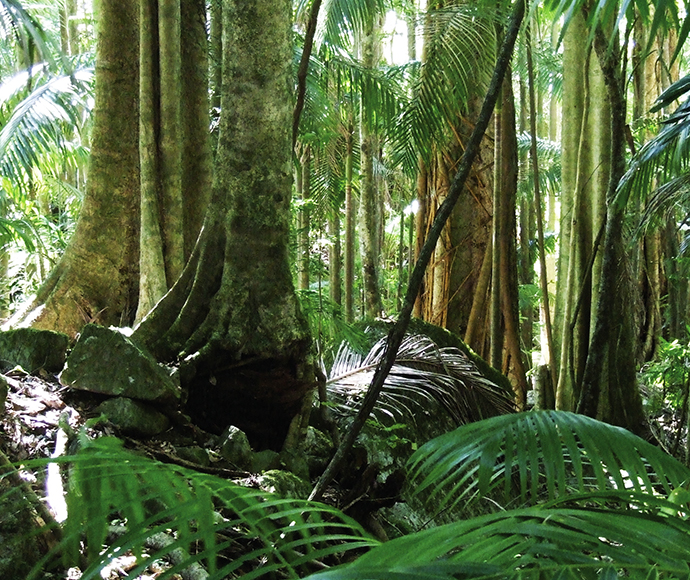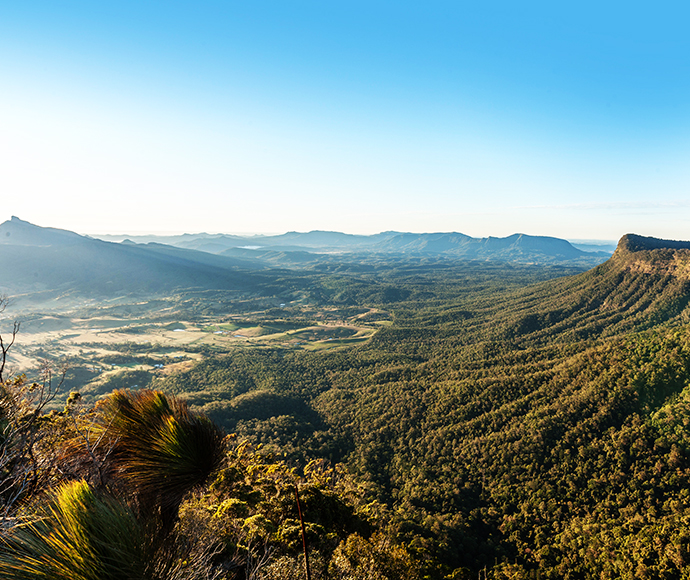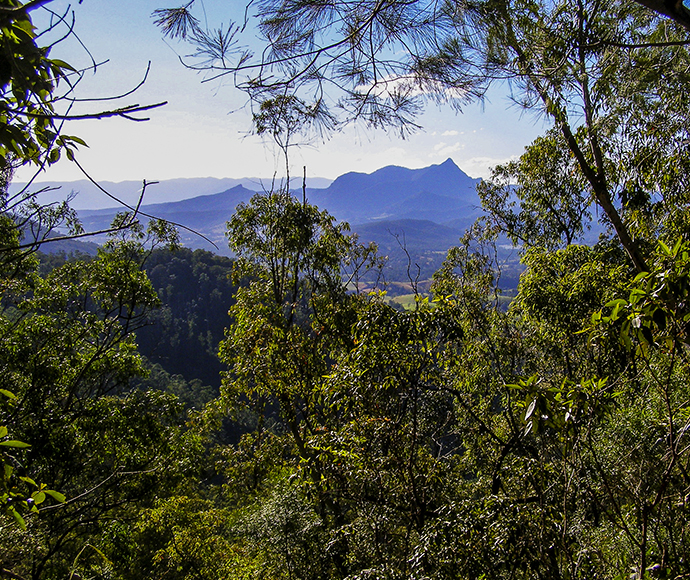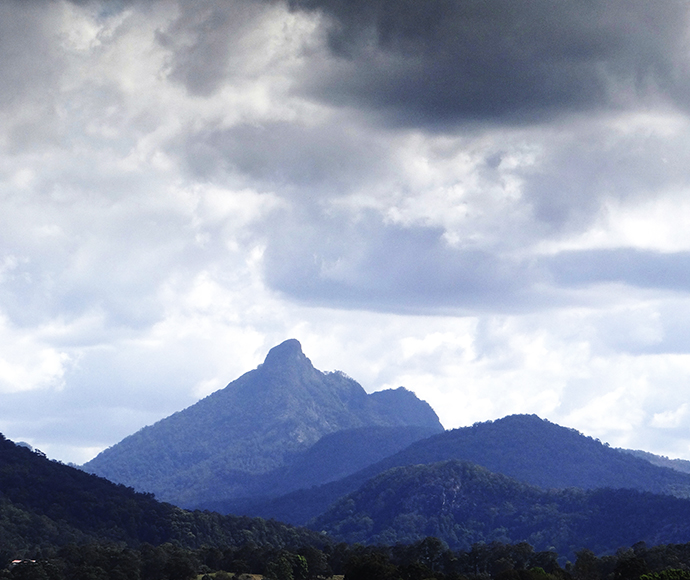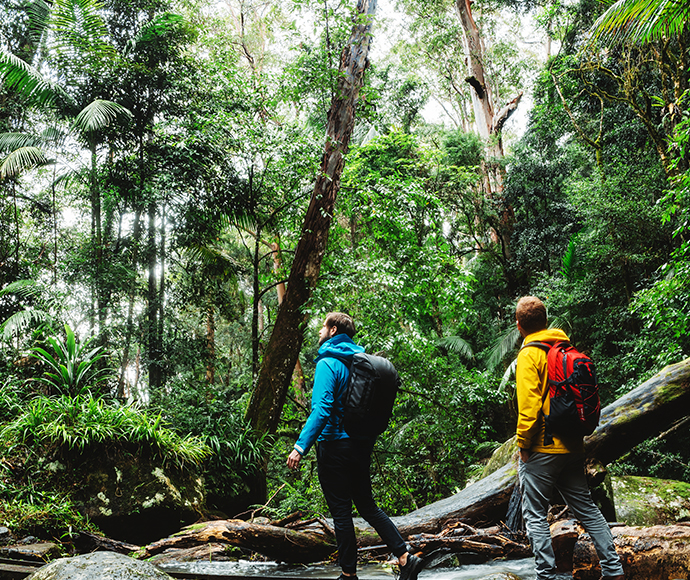The 4,117-hectare Wollumbin National Park (formerly Mount Warning National Park) is located 12 kilometres south-west of Murwillumbah on the Far North Coast of New South Wales.
Rising to a height of 1,157 metres above sea level, Wollumbin is a remnant central vent of an ancient volcano that 20 million years ago stretched from Mount Tamborine in the north to Lismore in the south. This spectacular feature can be viewed from a range of vantage points in the surrounding massive crater, The Tweed Caldera, one of the world's largest and best examples of an erosion caldera.
Wollumbin National Park is one of the most biodiverse areas in Australia and is a Gondwana Rainforests of Australia World Heritage Area, listed in 1986. It is home to over 200 rare and endangered plant and animal species. This includes Alberts lyrebird, tiger quolls, rose crowned fruit doves and several species of threatened plants.
Wollumbin – a highly sacred place
'Wollumbin is of the highest significance to the Aboriginal nations, particularly the Bundjalung nation in northern New South Wales, as a sacred ceremonial and cultural complex linked to traditional law and custom. Wollumbin is interconnected to a broader cultural and spiritual landscape, including Creation, Dreaming stories, and men's initiation rites of deep antiquity.
Bundjalung beliefs illustrate the spiritual values embodied and evoked in Wollumbin and its connections to a broader cultural landscape. These connections are important to the spiritual identity of the Bundjalung nation, many other nations and families connected to Wollumbin, predominantly men and also women.
We have a responsibility for caring for Country, our environment, plants, animals, water, earth and sky. As the oldest living culture in the world, we are sharing our cultural knowledge and entrusting this knowledge with the broader community so that our values, tradition, and law are respected, understood and acknowledged.'
– Wollumbin Consultative Group 2022
Aboriginal cultural values
Wollumbin is a traditional place of spiritual education, cultural lore and initiation to the Aboriginal peoples of north east New South Wales and south east Queensland, with songlines linking Aboriginal groups across the country to the area.
Mount Warning's cultural name is Wollumbin or more correctly pronounced (Wool-oom-bin), and is considered an extremely important part of the Aboriginal cultural landscape.
The declaration of the Aboriginal Place in 2014 recognises this significance and the stories or songlines that connect various Aboriginal communities who can see the mountain from their locality.
Wollumbin, which means 'cloud catcher' to some Aboriginal people, is the generally accepted Aboriginal name for the mountain and slope.
The rich oral traditions relating to Wollumbin reflect the complexity of Aboriginal culture and traditions. Bundjalung beliefs illustrate the spiritual values embodied and evoked in Wollumbin and its connections to a broader cultural landscape. These connections are important to the spiritual identity of the Bundjalung nation, and many other nations and families connected to Wollumbin Mountain. Women's places in their surroundings are interconnected to the mountain. The relationship between men's and women's business is based on a reciprocal relationship supporting each other's cultural responsibilities to the surrounding cultural landscapes and sacred connections to the mountain.
An Aboriginal Place
An Aboriginal Place Management Plan has been prepared to document Wollumbin's significant cultural heritage values and articulate the aspirations of Aboriginal communities about the long-term management of the site.
The plan was prepared in consultation with Aboriginal communities, including the Wollumbin Consultative Group, registered Aboriginal parties, Ngullingah Jugun Aboriginal Corporation, Yaegl Traditional Owner Aboriginal Corporation, and Bandjalang Aboriginal Corporation.
The National Parks and Wildlife Service and Wollumbin Consultative Group will develop a Memorandum of Understanding to guide the future management of Wollumbin National Park. This is the first step towards joint management between the National Parks and Wildlife Service and the Aboriginal custodians of Wollumbin National Park, appropriately recognising the Aboriginal cultural values of the area.
The development of a Memorandum of Understanding will provide a framework for Aboriginal decision-making about the national park.
An Aboriginal Place is an area of land that has special significance to Aboriginal people. It is legally declared by the Minister Environment and Heritage under the National Parks and Wildlife Act 1974 to recognise and protect Aboriginal cultural heritage sites.
It can have spiritual, historical, social, educational, natural resource use or other significance to Aboriginal people. These places range from small ceremonial sites to mountains and lagoons and have been identified all over New South Wales.
Aboriginal Places and other areas of significance are listed on the State Heritage Register.
The NSW National Parks and Wildlife Service is legally responsible for protecting the park's cultural heritage values and ensuring visitor safety, including managing the Aboriginal Place, in consultation with the Bundjalung People and broader Aboriginal communities.
The Wollumbin Consultative Group was established in 2000 to advise National Parks and Wildlife Service on the management of the highly significant Aboriginal Place, including preparing the Wollumbin Aboriginal Place Management Plan.
The Wollumbin Consultative Group represents a range of Aboriginal groups and families with connections to Wollumbin.
The group operates within an agreed formal consultation guideline, with representatives from Bundjalung and adjoining Aboriginal nations community members, Elders, Native Title claimants and corporations, Local Aboriginal Land Council, ancestral families and knowledge holders.
The current Wollumbin Consultative Group includes representatives from the following organisations:
- Tweed Byron Local Aboriginal Land Council
- Bundjalung Council of Elders
- adjacent Native Title claimants, the Githabul peoples, Widjabul Aboriginal people and Bundjalung of Byron Bay people
- representatives from family groups with knowledge and links to Wollumbin.
The Wollumbin Aboriginal Place Management Plan documents Wollumbin's significant cultural heritage values and articulates the aspirations of Aboriginal communities about the long-term management of the highly significant Aboriginal Place.
The plan complements the parks and reserves of the Tweed Caldera Plan of Management, providing direction for the management of the Wollumbin Aboriginal Place in accordance with the aspirations of the Aboriginal custodians.
We consulted with many stakeholders on the Wollumbin closures, including the local and regional tourism organisations and businesses, Tweed Shire Council, Aboriginal communities and other agencies before the closure. Stakeholders have been notified of the closure by email, through media releases and our web pages.
The Tweed Byron hinterland is a great place to explore lush forests of ancient figs, towering palms, waterfalls, and impressive views. Immerse yourself in this landscape and appreciate its exceptional beauty.
Some of the best views of Wollumbin can be found from The Pinnacle and Blackbutts lookouts in Border Ranges National Park. Byrrill Creek track in neighbouring Mebbin National Park and Minyon Falls in nearby Nightcap National Park are spectacular walks through forest and along lush rainforest-lined creeks.
Best of All Lookout, in Queensland's Springbrook National Park, also provides a stunning view of Wollumbin.
Check the National Parks and Wildlife Service website for updated and closure alerts before you visit.
New Wollumbin Stakeholder Advisory Committee
The National Parks and Wildlife Service has also established the Wollumbin Stakeholder Advisory Committee to provide a forum for key stakeholders, including local government and the tourism industry, to provide their views to Aboriginal custodians about future management of Wollumbin.
This advisory committee also provides a forum for representatives to share their views and provide feedback on future recreational opportunities and visitor experiences, in other national parks in the Tweed Byron Area.
The NSW Government seeks an outcome that appropriately safeguards the significance of the Aboriginal Place at Wollumbin, while supporting a range of tourism experiences in the region.
The Wollumbin Stakeholder Advisory Committee includes representatives from:
- Tweed Tourism Council
- Destination North Coast
- Member for Lismore
- Member for Tweed
- Tweed Shire Council
- Byron Bay Shire Council
- Murwillumbah Chamber of Commerce
- Southern Cross University
- Northern Rivers Bushwalk Club.
Wollumbin Consultative Group representatives are also invited to attend.
Supporting tourism in the Tweed area
The National Parks and Wildlife Service is delivering $9.5 million of visitor infrastructure improvements in the Tweed and its surrounds, including the $7.35 million Gidjuum Gulganyi Walk (formerly referred to as the Tweed Byron Hinterland Walk) project, a stunning 38-kilometre, 4-day hiking trail through Mount Jerusalem and Nightcap national parks that is due for completion in 2024.
Stage 1 of the project, the redevelopment of the Minyon Falls lookout (Nightcap National Park) precinct, was opened in 2021 and Stage 2, Unicorn Falls (Mount Jerusalem National Park) in 2022. They are both beautiful day trips within the Tweed Byron hinterland. Works are now underway to construct the 3 campgrounds.
We are also planning the Caldera Rim Walk in Wollumbin National Park, an 8-kilometre return walk with rainforest, caldera rim and mountain views.
Caldera Rim Walk draft master plan
Consultation on the draft master plan in Wollumbin National Park has closed.
The National Parks and Wildlife Service is evaluating the submissions and continuing to evaluate the proposal's feasibility.
The information you provide in this form will only be used for the purpose for which it was collected. By submitting, you consent to storage, use, and disclosure of your personal information in accordance with our privacy policy. You can request access and amendment of your personal information.
More information
- Wollumbin National Parkopens a new window
- NPWS Wollumbin State Conservation Areaopens a new window
- Blackbutt lookout picnic areaopens a new window
- Byrrill Creek walking trackopens a new window
- Minyon Falls lookoutopens a new window
- Pinnacle walk and lookoutopens a new window
- Border Ranges National Parkopens a new window
- NPWS Border Ranges National Park current alertsopens a new window
- Tweed Byron Hinterland Trails
- Aboriginal joint management of parks
- Gondwana Rainforests of Australia
